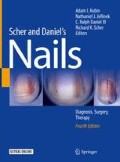Abstract
Nail surgery allows practitioners to diagnose or treat the majority of nail conditions. Successful nail surgery requires knowledge of anatomy and pathology, which have been detailed in prior chapters. This chapter reviews reliable approaches to common office-based procedures, including plate, bed, and matrix surgery, with punch, shave, and fusiform techniques. With a strong foundation of nail anatomy and pathology, surgeons can use these basic and intermediate surgical techniques to diagnose or treat a wide array of nail conditions.
Access this chapter
Tax calculation will be finalised at checkout
Purchases are for personal use only
References
Daniel CR 3rd, Jellinek NJ. Subungual blood is not always a reassuring sign. J Am Acad Dermatol. 2007;57:176.
Braun RP, Baran R, Saurat JH, Thomas L. Surgical pearl: dermoscopy of the free edge of the nail to determine the level of nail plate pigmentation and the location of its probable origin in the proximal or distal nail matrix. J Am Acad Dermatol. 2006;55:512–3.
Haneke E, Baran R. Longitudinal melanonychia. Dermatol Surg. 2001;27:580–4.
Jellinek N. Nail matrix biopsy of longitudinal melanonychia: diagnostic algorithm including the matrix shave biopsy. J Am Acad Dermatol. 2007;56:803–10.
Richert B, Theunis A, Norrenberg S, Andre J. Tangential excision of pigmented nail matrix lesions responsible for longitudinal melanonychia: evaluation of the technique on a series of 30 patients. J Am Acad Dermatol. 2013;69:96–104.
Jellinek NJ, Velez NF, Knackstedt TJ. Recovery after matrix shave biopsy. Dermatol Surg. 2016;42:1227–9.
Jellinek NJ, Rubin AI. Lateral longitudinal excision of the nail unit. Dermatol Surg. 2011;37:1781–5.
El-Shaer WM. Lateral fold rotational flap technique for treatment of ingrown nail. Plast Reconstr Surg. 2007;120:2131–3.
De Berker DA, Baran R. Acquired malalignment: a complication of lateral longitudinal nail biopsy. Acta Derm Venereol. 1998;78:468–70.
Reardon CM, McArthur PA, Survana SK, Brotherston TM. The surface anatomy of the germinal matrix of the nail bed in the finger. J Hand Surg Br. 1999;24:531–3.
Baran R, Perrin C. Longitudinal erythronychia with distal subungual keratosis: onychopapilloma of the nail bed and Bowen’s disease. Br J Dermatol. 2000;143:132–5.
Tosti A, Schneider SL, Ramirez-Quizon MN, Zaiac M, Miteva M. Clinical, dermoscopic, and pathologic features of onychopapilloma: a review of 47 cases. J Am Acad Dermatol. 2016;74(3):521–6.
Jellinek NJ. Longitudinal erythronychia: suggestions for evaluation and management. J Am Acad Dermatol. 2011;64(167):e161–11.
Collins SC, Cordova KB, Jellinek NJ. Midline/paramedian longitudinal matrix excision with flap reconstruction: alternative surgical techniques for evaluation of longitudinal melanonychia. J Am Acad Dermatol. 2010;62:627–36.
McDermott EM, Weiss AP. Glomus tumors. J Hand Surg Am. 2006;31:1397–400.
Bhaskaranand K, Navadgi BC. Glomus tumour of the hand. J Hand Surg Br. 2002;27:229–31.
Trehan SK, Athanasian EA, DiCarlo EF, Mintz DN, Daluiski A. Characteristics of glomus tumors in the hand not diagnosed on magnetic resonance imaging. J Hand Surg Am. 2015;40:542–5.
Roan TL, et al. Surgical technique innovation for the excision of subungual glomus tumors. Dermatol Surg. 2011;37:259–62.
Lee IJ, Park DH, Park MC, Pae NS. Subungual glomus tumours of the hand: diagnosis and outcome of the transungual approach. J Hand Surg Eur Vol. 2009;34:685–8.
Lin YC, Wu YH, Scher RK. Nail changes and association of osteoarthritis in digital myxoid cyst. Dermatol Surg. 2008;34:364–9.
de Berker D, Goettman S, Baran R. Subungual myxoid cysts: clinical manifestations and response to therapy. J Am Acad Dermatol. 2002;46:394–8.
Lawrence C. Skin excision and osteophyte removal is not required in the surgical treatment of digital myxoid cysts. Arch Dermatol. 2005;141:1560–4.
Baran R, Haneke E, Richert B. Pincer nails: definition and surgical treatment. Dermatol Surg. 2001;27:261–6.
Cho YJ, Lee JH, Shin DJ, Sim WY. Correction of pincer nail deformities using a modified double Z-plasty. Dermatol Surg. 2015;41:736–40.
Author information
Authors and Affiliations
Corresponding author
Editor information
Editors and Affiliations
34.1 Electronic Supplementary Materials
The matrix shave technique is demonstrated with partial proximal plate avulsion, in the setting of biopsy of longitudinal melanonychia (MP4 548,119 kb)
The lateral longitudinal biopsy technique is demonstrated, with key points focusing on complete matrix horn excision (MP4 379,959 kb)
A technique to biopsy longitudinal erythronychia with the suspicion of the diagnosis of onychopapilloma is demonstrated (MP4 417,519 kb)
Rights and permissions
Copyright information
© 2018 Springer International Publishing AG, part of Springer Nature
About this chapter
Cite this chapter
Miller, C.J., Jellinek, N.J., Damavandy, A., Etzkorn, J.R., Sobanko, J.F., Shin, T.M. (2018). Basic and Intermediate Complexity Nail Procedures. In: Rubin, A.I., Jellinek, N.J., Daniel, C.R., Scher, R.K. (eds) Scher and Daniel’s Nails. Springer, Cham. https://doi.org/10.1007/978-3-319-65649-6_34
Download citation
DOI: https://doi.org/10.1007/978-3-319-65649-6_34
Publisher Name: Springer, Cham
Print ISBN: 978-3-319-65647-2
Online ISBN: 978-3-319-65649-6
eBook Packages: MedicineMedicine (R0)

